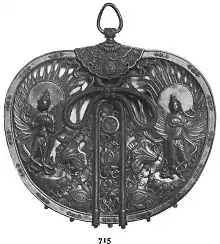Keman
Keman (華鬘(けまん)) (Japanese phoneticization from the Sanskrit kusumamālā "Garland of Flowers"[2]), is a Buddhist ritual decoration, placed hanging on the beam of the inner sanctuary before the enshrined Buddha, in the main hall of the temple.[3]

As its Sanskrit name suggests, it originated as a term for fresh flowers strung together and tied in a loop,[2] but became a name for such implements as used to pay respect to the dead (hotoke),[2] and eventually signified ritual implements ornamenting the inner sanctuary (naijin (内陣), corresponding to the chancel of a church.[2]
They are typically made from gilt bronze in the shape of a round fan (uchiwa).[3] Other materials used for making it are oxhide,[2] wooden boards,[2][3] or threads.[2][3] The design may feature karyobinga (harpy-like beings), or use foliage scroll-work (karakusa) combined with the hōsōge (imaginary peony-like floral pattern), lotus, or peony.[2] A well-known example is the keman from the Golden Hall of Chūson-ji in Northern Japan, designated National Treasure.
Popular culture
- keman-sō (ケマンソウ) is the Japanese name for the wildflower "Lamprocapnos spectabilis" (also known under genus Dicentra; common name "bleeding heart"), so named because the flower's shape resembles the keman ornament.
References
- Matsuki, Bunkio (1903). Catalogue of rare objects in brass, leathers and wood illustrating the art of old Japan: to be sold at unrestricted public sale by order of Bunkio Matsuki : the sale will be conducted by Thomas E. Kirby of the American Art Association (google). American Art Association. p. 2.CS1 maint: ref=harv (link)
- Shinchosha (1985). 新潮世界美術事典 (Shincho Encyclopedia of World Art). Shinchosha. ISBN 4-10-730206-7.
- Tokyo National Museum (1976). 和英対照日本美術鑑賞の手引(An Aid to the Understanding of Japanese Art).CS1 maint: ref=harv (link) (revised edition; 1964 first ed.), p.132/133
